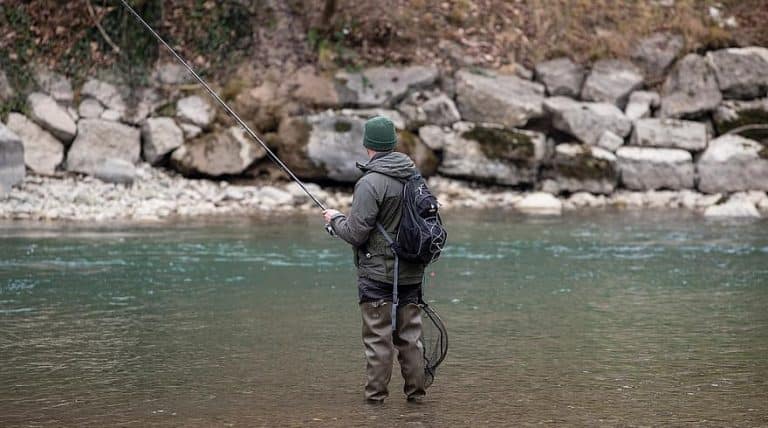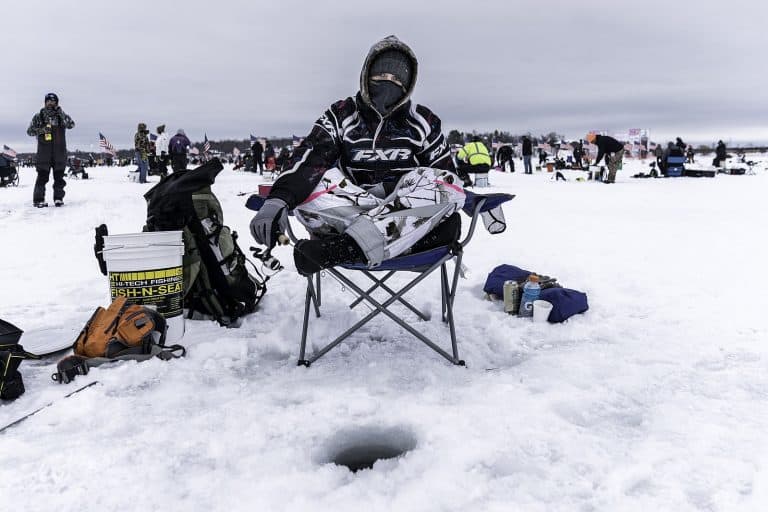5 Best Ice Fishing Boots
When it comes to ice fishing, the boots you use are one of the most important pieces of kit. They will help keep you warm, dry and safe out on the ice, and are essential if you take yourself and your ice fishing seriously.
The risk of using improper footwear is grisly and highly serious. Ice fishing is a dangerous activity and the elements are well and truly against you.
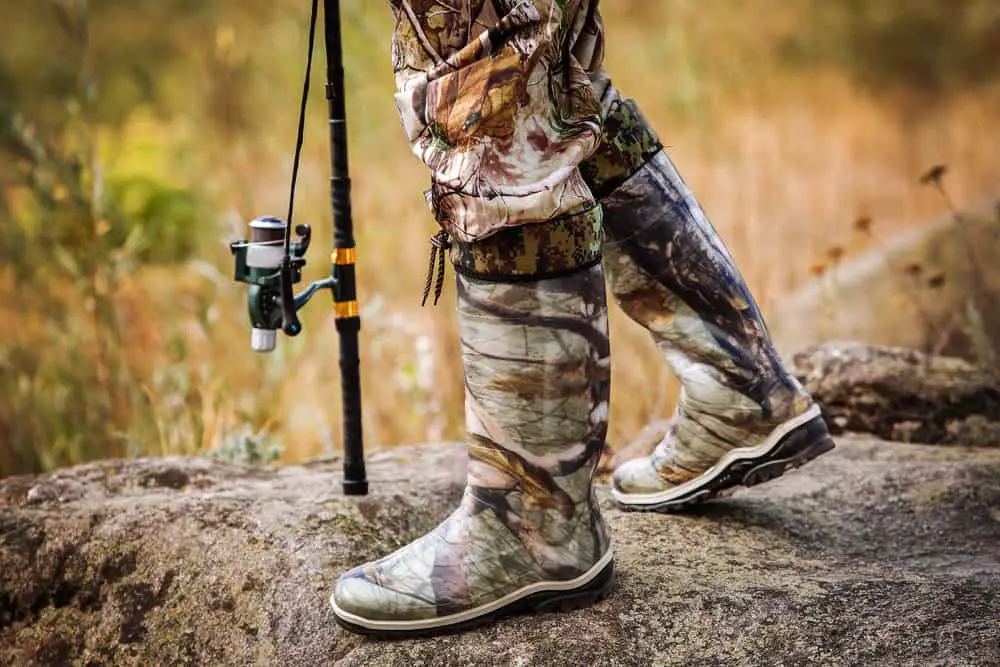
Cold weather, freezing water and slippery ice mean that most footwear simply isn’t up to the challenge posed by ice fishing, and can cause potentially fatal injuries or at the very least make your time out on the ice far more unpleasant than it has to be.
Ice fishing boots are made specifically to increase your safety and comfort while ice fishing, and use an array of features to achieve this, from superior insulation, to excellent waterproofing and grippy, well designed soles for maximum grip and comfort.
However finding the right pair of ice fishing boots for you can be quite difficult, as there are many to choose from and a lot of different styles which provide various different benefits and drawbacks.
In this article we’re going to review 5 of the best ice fishing boots available, from some of the leading brands to give you a range of options as well as some inspiration about what boot may be best suited for you and your needs.
We’re going to look at their various features, pros, and cons to make sure you know exactly what you’re getting.
We’re also going to include a buyers guide below the individual boots, to give some key information about what to look for in a great ice fishing boot, and help you to make an informed decision about what boot may be best for you.
There’s also an FAQ below the buyers guide, with some commonly asked questions about ice fishing boots to help you spend less time confused and more time planning your next ice fishing trip.
But let’s take a look at the boots themselves, and look at their various pros, and cons.
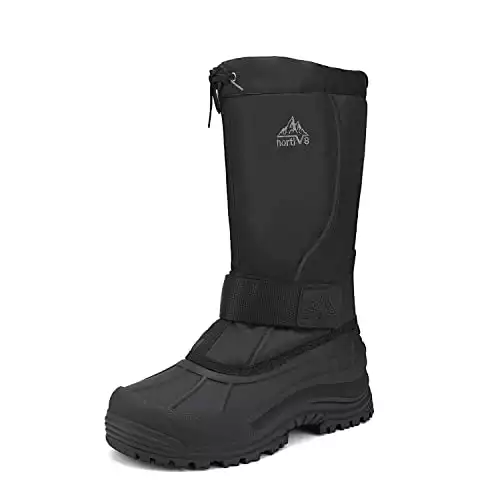 NORTIV 8 Men's
NORTIV 8 Men's
Nortiv produces some of the best snow boots available, and the Nortiv 8 comes with a host of excellent features that make it a superb boot for ice fishing.
The sole has a very well designed aggressive tread with comfortable arches and the rubberized material extends over the entire lower of the boot for superior waterproofing and protection from the elements, whether it be wind, snow or rain.
The boots also come with protective toe caps to provide additional protection for working with your auger or other tools such as picks.
The multi-layer interior is designed for heat retention and warmth, with several layers incorporating faux fur and thermal layers for maximum comfort in extremely low temperatures.
The seams are well sealed and the laces are strong, with very well located eyelets which are secure and provide great convenience for fast lacing and tightening.
The boots are easy to put on and take off, comfortable and study, and the only drawback to them is that they are a little less protective and sturdy than one piece, non laced boot designs.
Pros
- Thermoplastic Elastomers sole - Excellent grip
- Multi layer interior including faux fur for maximum insulation and warmth
- Seam-sealed highly waterproof outsole for superior waterproofing
- Non-slip outsole
- Protective toe caps
Cons
- Laced design is a little less sturdy than some other options
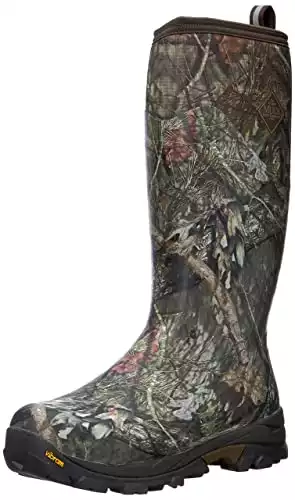 Muck Boots Woody Arctic
Muck Boots Woody Arctic
Muck boots are one of the best brands in hardworking boots for industrial and agricultural use, and their several decades of experience have gone into making an arctic boot designed to face the unique challenges and rigors of ice fishing with the Woody Arctic.
Featuring a neoprene construction, these boots are incredibly waterproof and wind resistant but still provide surprising flexibility for a boot of this style.
The interior fleece lining is soft and comfortable, as well as very warm and this, combined with the additional thermal foam footbed makes the boots excellent for use in the harshest temperatures, and are rated to be used in conditions as low as -50 degrees Celsius.
The Vibram soles are specially designed for grip and comfort with aggressive treads to keep you on your feet at all times, and the Spandura top seal works well to keep water out.
The only downside is that these boots don’t have laces, so getting a proper fit is a little trickier than with laced designs.
Pros
- Neoprene Construction for Maximum Waterproofing and Flexibility
- Soft Fleece lining with thermal foam footbed
- Rated to -50 degrees celsius up to -1 degrees celsius
- Vibram Arctic Grip outsole provides superb traction
- Spandura top seal
Cons
- A little bit rigid
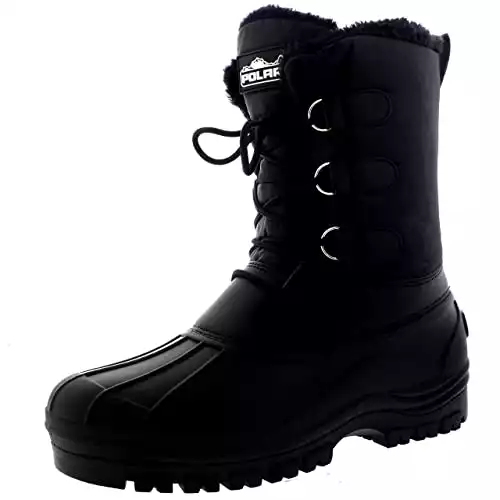 Polar Mens Muck Lace Up
Polar Mens Muck Lace Up
These boots from Polar are a great option for less extreme ice fishing environments, but come with the features you need to be safe and comfortable if conditions do go south.
The first nice feature is that they are fully fur lined which not only looks very cool, but crucially provides excellent warmth and comfort for long days out on the ice.
The soles are anti-slip and have fairly strong treads however they aren’t as aggressive as some other designs.
The laces are strong, as are the eyelets, and this allows for a very comfortable and secure fit around your foot which helps keep you well insulated and prevents rubbing or discomfort.
The only downside to these boots is that they aren’t quite as big and protective as some other designs, stopping a little lower on the leg. This may make them more comfortable for you, however.
Pros
- Fully fur lined
- Anti-slip sole
- Deep treads for excellent grip
- Strong laces and eyelets for comfort and secure fitting
- Rubberised lower for excellent waterproofing
Cons
- The uppers don’t reach quite as high on the leg as some other boots
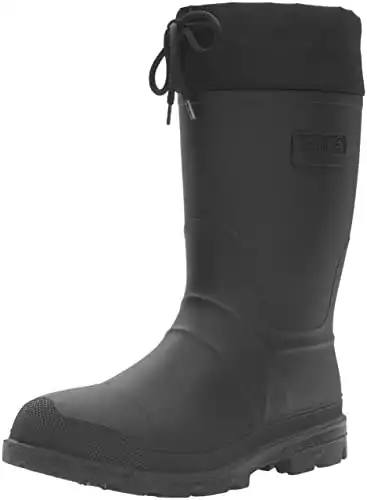 Kamik Men's Icebreaker
Kamik Men's Icebreaker
The Kamik Icebreaker is one of the best work boots for ice fishing, and lives up to its name with a host of ice fishing focused features.
These boots are comprehensively waterproof, with a fully rubberized design making them nearly impervious to leaks and water ingress.
The thermal layers within work well to keep you warm, and are also capable of moisture wicking to keep you sweat free. The liners are also removable for easy cleaning and maintenance.
The treads are a little less aggressive than some others, but they are self cleaning which helps keep them clear for gripping.
Pros
- Highly waterproof fully rubber design
- Removable thermal liner for warmth and easy cleaning
- Moisture wicking lining to prevent sweat build up
- Waterproof, sealable top collar
- Self cleaning lug outsoles
Cons
- Tread design could be a little more aggressive
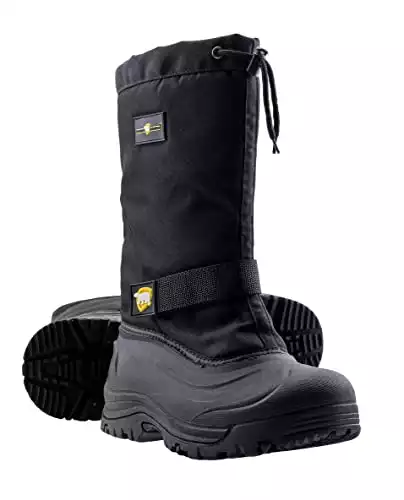 ArcticShield Mens Cold Weather Snow Boots
ArcticShield Mens Cold Weather Snow Boots
Finally, we have the ArcticShield Snow Boots.
These are another superb choice rated for use in conditions as low as -40 degrees Fahrenheit, and are very waterproof thanks to the rubberized lowers and high quality seals.
The interior has a patented heat retention system for keeping your feet warm in even the toughest conditions, and the only downside is that the lack of laces on this boot makes it a little less secure and comfortable than some others.
Pros
- Rated to -40 degrees Fahrenheit
- Waterproof
- Excellent insulation
- Comfortable
- Relatively lightweight
Cons
- A little less secure due to lack of laces
Buyers Guide
Finding a good pair of ice fishing boots can be really difficult, as it’s a very competitive market with many outstanding brands all competing to provide the best performance and prices, and using various designs, materials, and construction methods which creates a vast selection of boots with a wide range of capabilities.
Trying to decipher which boot is going to suit your needs best can be time consuming, and even if you’re an experienced ice fisher, the latest designs and capabilities of ice fishing boots can be hard to keep track of.
In this buyers guide we’re going to look at some of the key characteristics of a good ice fishing boot so that you can be aware of exactly what to look for in a quality new pair of boots, focusing on what you need to get back out on the ice as soon as possible.
Waterproofing
Waterproofing is one of the most important parts of any ice fishing boot. Frozen lakes are naturally very wet places, so a good standard of waterproofing is key.
Ice fishing boots achieve this in a few ways, the first being a very well constructed lower, usually made from rubber or other synthetic material which is tough and highly waterproof. The best boots have an almost seamless lower making gaps and places where water can enter the boot nearly nonexistent, which is perfect for ice fishing.
The uppers can vary, with some boots choosing to use a continuous rubberised upper that is made of one piece attached to the lower of the boot. This creates the best waterproofing, however can be a little less comfortable and warm compared to other designs which may use other materials for the upper.
The stitching in areas where different parts of the boot connect needs to be top quality, and the best boots achieve this by double stitching.
The area of the laces is also typically well made with no gaps for water to pass into the main part of the boot, helping to keep your feet dry and warm.
Finally, the laces and fasteners themselves are usually made to create a very tight and secure fit, and some boots even have laces to tighten the top of the boot against your leg to reduce the chance of snow or splashing water from finding its way into your boot from above.
These are all key features to look for in an ice fishing boot and are the hallmark of most popular and well made boots.
Cold Weather Rating
All ice fishing or snow boots should have a cold weather rating, as this is a great and simple way to determine how safe your boot is for the environment you intend to use it in.
Some boots are capable of temperatures as low as -40 or even -50 degrees, while others can handle -25 or even less, depending on a variety of factors, the most important being their construction and the materials used within.
One important thing to remember is that a boot capable of -50 degrees may not be the most practical or necessary, and while a better cold weather rating makes the boot warmer at those lower temperatures, it doesn’t necessarily mean it will perform better than another boot at more reasonable temperatures, where the size and weight of warmer boots can make you uncomfortable or slow you down.
As with most things when equipping yourself, it’s important to keep in mind your own personal requirements. Where do you intend to ice fish? How long do you intend to do it for? How harsh and remote is the environment?
These questions will help you determine whether you really need a -50 degree celsius boot, or whether a short ice fishing trip might require something a little less extreme.
Insulation
The insulation of your boot is key to keeping your feet and toes warm out on the ice. Ice fishing naturally takes place on large open areas of water, and these can be some of the harshest conditions in terms of sheer coldness due to a combination of factors.
The ice and the water beneath act as a sink which draws in cold, expelling heat completely. Another factor is that these places tend to be wide open and prone to cutting wind, and then of course there’s the frozen water you’re standing on itself, which has a nasty habit of finding its way into every crevice and thoroughly chilling your body temperature.
Your feet will be some of the most vulnerable of all your extremities when it comes to nasty issues such as frostbite, so top tier insulation is key.
The best boots will use a combination of furs or synthetic materials to make sure your toes are well looked after, however some boots use additional features such as specially designed thermal layers to help you retain as much heat as possible.
Soles and Traction
Besides being cold and wet, ice completes its treacherous character by also being dangerously slippery. Many ice fishers are well aware of the dangers of cold and wet while out on the ice, but some people forget just how dangerous a fall can be.
These accidents can cause lasting damage to your body, whether it be your knee, your back or any other parts of your body which take a hit and this can be even worse out on the ice, potentially leaving you immobilized and exposed out in one of the most dangerous places in the world.
Hypothermia or getting stranded are real concerns should this happen, however you can protect yourself by ensuring your boots are grippy and give plenty of traction while out on the ice.
Some people like to use additional attachments such as chains or spikes on their boots, which can be a real help, however the boots themselves should still have a very grippy material for the exterior sole and be designed to keep your feet planted firmly on the ground.
The design of the tread itself often varies widely between brands, but it should always be very deep with plenty of edges and cuts to help grab whatever grip is available.
Some boots use Vibram which is a quality proprietary material which provides superb grip and comfort, while others use standard rubberized soles which still provide very good grip.
A relatively wide surface area will help add grip and balance, and boots often come with a heel and arch to help with mounting accessories for added grip, as well as comfort and insulation.
Lacing/Fastening
The way your boot fastens is really important for a few reasons. First and foremost, this will keep your boot secure during arduous and difficult conditions, however it also helps keep your feet safe from water and helps them retain heat more effectively.
Some boots use very strong laces much like hiking boots, however these are usually set up to be far more durable and high quality than normal hiking boots, to increase tolerances and improve insulation and waterproofing.
Eyelets are commonly used in this setup to make the boot fit very securely, and to increase comfort and also convenience, keeping the laces in place during the most difficult conditions.
Alternatively, some boots only use a lace or fastener at the very top of the boot where it stops above your ankle. The benefit of this is that the boot will be much more waterproof and less prone to coming undone, however not having laces can make the boot a little less convenient, being harder to put on and take off.
Some boots opt for a combination of these features to get a compromise, while others include additional straps to help keep everything secure and in place should the wind pick up or conditions become very difficult.
Materials
The materials used in ice fishing boots vary a lot, however they are often comprised of a rubber or vibram outer sole, with synthetic fibres such as Thinsulate and other materials for insulation, and sometimes fur or imitation fur for premium insulation and warmth.
Naturally, the best boots will use real fur and proprietary materials such as vibram, however there are plenty of good boots which use cheaper components but are very well made, and hold up just as well as expensive boots.
Many boots will also use steep tips, to give support and protection to the toe area and sometimes even the heel area. This may not suit everyone as naturally this will affect the comfort and weight of the boot, so look out for this in particular if you do or don’t want the extra protection provided by steel caps.
Comfort/Stiffness
As with all boots, the initial comfort will be lacking and stiffness will be high. Ice fishing boots will need to be broken in a little to become truly comfortable and suitable for use in the real elements, however some boots are easier to break in than others.
Boots that lace up are a little easier to break in and are of course more comfortable as you can easily control the tightness of the boot on your foot.
Boots which are solid and don’t use laces will of course be more difficult to break in, however can be quite comfortable once they are.
Socks
It doesn’t matter how well insulated your boots are, pairing them with proper socks and even boot warmers is the best way to stave off frostnip or frostbite, so don’t cut corners here and get a quality sock to go with your new boots!
F.A.Q
Do I need to get a size bigger to accommodate warm socks?
This is a very common tactic however this isn’t necessary with ice fishing boots. Proper snow boots and ice fishing boots are designed to accommodate winter socks and are naturally a little roomier and wider to give you space to wear whatever socks you need.
You should stick to the right size for you to avoid issues with comfort and fit which can cause blisters and chafing if the boots are too large or your foot moves around within them too much.
Do boots stretch?
This depends a lot on the brand and the materials used,however boots can be broken in a little and may stretch a little bit over time as it moulds to your particular foot and your gait.
Some boots will stretch more than others however, so don’t expect a massive amount of additional space to appear.
Are boots better tight or loose?
Boots should be neither too tight or too loose.
Boots that are too tight restrict blood flow and can actually exacerbate the risks of frostbite, especially if you’re ice fishing.
Too loose however and the boot will lose heat more easily, and will also be uncomfortable, causing blisters and chafing.
Something tight enough to be secure and retain heat but loose enough to allow blood flow and comfort is best.

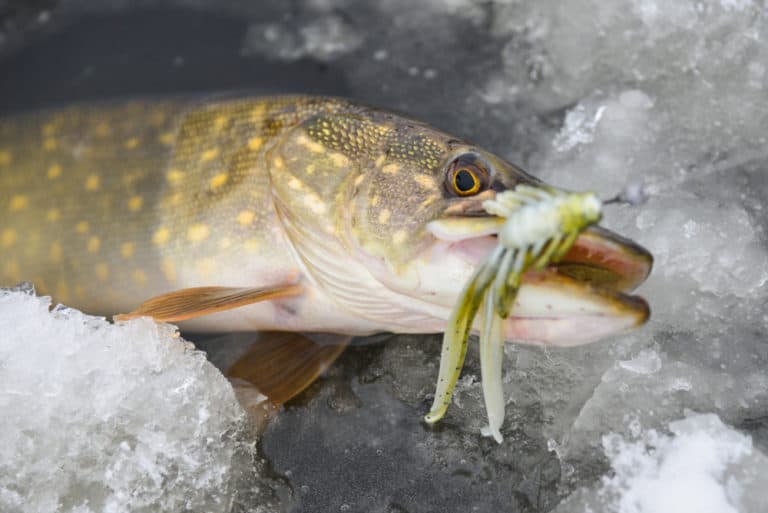
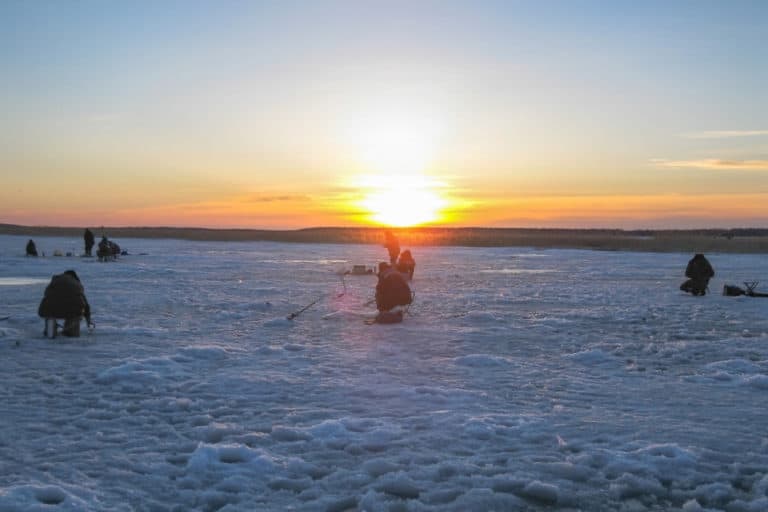
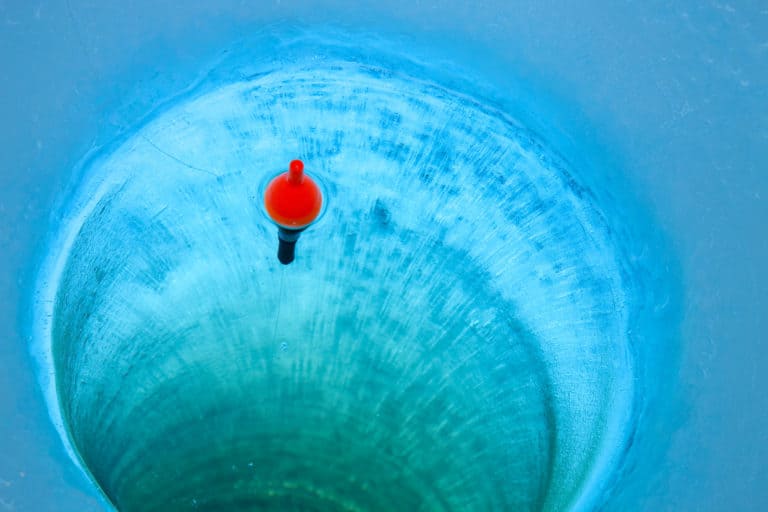
![7 Best Fishing Pliers [In-depth Reviews & Buyers Guide]](https://watersportingadventure.com/wp-content/uploads/2020/10/pexels-shane-kell-2431454-scaled-e1602751936800-768x336.jpg)
